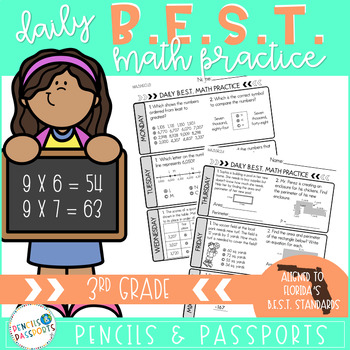Florida B.E.S.T. 3rd Grade Math Standards Daily Practice Homework Test Prep
- Zip
What educators are saying
Description
Here’s your resource to review and supplement the 3rd grade Florida BEST Math Standards and are aligned to Florida Assessment of Student Thinking (F.A.S.T.) test item specifications. We use this as a weekly homework assignment, but can also be used for morning work, small groups, review, test prep, and bell work.
**This product is now complete!**
Looking for 4th grade practice? Click Here!
MA.3.NSO.1 UNDERSTAND THE PLACE VALUE OF FOUR-DIGIT NUMBERS.
MA.3.NSO.1.1 Read and write numbers from 0 to 10,000 using standard form, expanded form and word form.
MA.3.NSO.1.2 Compose and decompose four-digit numbers in multiple ways using thousands, hundreds, tens and ones. Demonstrate each composition or decomposition using objects, drawings and expressions or equations.
MA.3.NSO.1.3 Plot, order and compare whole numbers up to 10,000.
MA.3.NSO.1.4 Round whole numbers from 0 to 1,000 to the nearest 10 or 100.
MA.3.NSO.2 ADD AND SUBTRACT MULTI-DIGIT WHOLE NUMBERS. BUILD AN UNDERSTANDING OF MULTIPLICATION AND DIVISION OPERATIONS.
MA.3.NSO.2.1 Add and subtract multi-digit whole numbers including using a standard algorithm with procedural fluency.
MA.3.NSO.2.2 Explore multiplication of two whole numbers with products from 0 to 144, and related division facts.
MA.3.NSO.2.3 Multiply a one-digit whole number by a multiple of 10, up to 90, or a multiple of 100, up to 900, with procedural reliability.
MA.3.NSO.2.4 Multiply two whole numbers from 0 to 12 and divide using related facts with procedural reliability.
MA.3.FR.1 UNDERSTAND FRACTIONS AS NUMBERS AND REPRESENT FRACTIONS.
MA.3.FR.1.1 Represent and interpret unit fractions in the form 1/ as the quantity formed by one part when a whole is partitioned into n equal parts.
MA.3.FR.1.2 Represent and interpret fractions, including fractions greater than one, in the form of / as the result of adding the unit fraction 1/ to itself times.
MA.3.FR.1.3 Read and write fractions, including fractions greater than one, using standard form, numeral-word form and word form.
MA.3.FR.2 ORDER AND COMPARE FRACTIONS AND IDENTIFY EQUIVALENT FRACTIONS.
MA.3.FR.2.1 Plot, order and compare fractional numbers with the same numerator or the same denominator.
MS.3.FR.2.2 Identify equivalent fractions and explain why they are equivalent.
MA.3.AR.1 SOLVE MULTIPLICATION AND DIVISION PROBLEMS
MA.3.AR.1.1 Apply the distributive property to multiply a one-digit number and two-digit number. Apply properties of multiplication to find a product of one-digit whole numbers.
MA.3.AR.1.2 Solve one- and two-step real-world problems involving any of four operations with whole numbers.
MA.3.AR.2 DEVELOP AN UNDERSTANDING OF EQUALITY AND MULTIPLICATION AND DIVISION
MA.3.AR.2.1 Restate a division problem as a missing factor problem using the relationship between multiplication and division.
MA.3.AR.2.2 Determine and explain whether an equation involving multiplication or division is true or false.
MA.3.AR.2.3 Determine the unknown whole number in a multiplication or division equation, relating three whole numbers, with the unknown in any position.
MA.3.AR.3 IDENTIFY NUMERICAL PATTERNS, INCLUDING MULTIPLICATIVE PATTERNS.
MA.3.AR.3.1 Determine and explain whether a whole number from 1 to 1,000 is even or odd.
MA.3.AR.3.2 Determine whether a whole number from 1 to 144 is a multiple of a given one digit number.
MA.3.AR.3.3 Identify, create and extend numerical patterns.
MA.3.M.1 MEASURE ATTRIBUTES OF OBJECTS AND SOLVE PROBLEMS INVOLVING MEASUREMENT.
MA.3.M.1.1 Select and use appropriate tools to measure the length of an object, the volume of liquid within a beaker and temperature.
MA.3.M.1.2 Solve real-world problems involving any of the four operations with whole number lengths, masses, weights, temperatures or liquid volumes.
MA.3.M.2 TELL AND WRITE TIME AND SOLVE PROBLEMS INVOLVING TIME.
MA.3.M.2.1 Using analog and digital clocks tell and write time to the nearest minute using a.m. and p.m. appropriately.
MA.3.M.2.2 Solve one- and two-step real-world problems involving elapsed time.
MA.3.GR.1 DESCRIBE AND IDENTIFY RELATIONSHIPS BETWEEN LINES AND CLASSIFY QUADRILATERALS.
MA.3.GR.1.1 Describe and draw points, lines, line segments, rays, intersecting lines, perpendicular lines and parallel lines. Identify these in two-dimensional figures.
MA.3.GR.1.2 Identify and draw quadrilaterals based on their defining attributes. Quadrilaterals include parallelograms, rhombi, rectangles, squares and trapezoids.
MA.3.GR.1.3 Draw line(s) of symmetry in a two-dimensional figure and identify line symmetric two-dimensional figures.
MA.3.GR.2 SOLVE PROBLEMS INVOLVING THE PERIMETER AND AREA OF RECTANGLES.
MA.3.GR.2.1 Explore area as an attribute of a two-dimensional figure by covering the figure with unit squares without gaps or overlaps. Find areas of rectangles by counting unit squares.
MA.3.GR.2.2 Find the area of a rectangle with whole-number side lengths using a visual model and a multiplication formula.
MA.3.GR.2.3 Solve mathematical and real-world problems involving the perimeter and area of rectangles with whole-number side lengths using a visual model and a formula.
MA.3.GR.2.4 Solve mathematical and real-world problems involving the perimeter and area of composite figures composed of non-overlapping rectangles with whole number side lengths.
MA.3.DP.1 COLLECT, REPRESENT AND INTERPRET NUMERICAL AND CATEGORICAL DATA.
MA.3.DP.1.1 Collect and represent numerical and categorical data with whole-number values using tables, scaled pictographs, scaled bar graphs or line plots. Use appropriate titles, labels and units.
MA.3.DP.1.2 Interpret data with whole-number values represented with tables, scaled pictographs, circle graphs, scaled bar graphs or line plots by solving one- and two-step problems.
MIXED REVIEW
B.E.S.T. STANDARDS: NSO and AR MA.3.NSO.2.1, MA.3.AR.1.2, MA.3.AR.3.3
B.E.S.T. STANDARDS: M, GR, DP MA.3.M.2.2, MA.3.GR.1.2, MA.3.DP.1.1/1.2
B.E.S.T. STANDARDS: NSO, FR, AR MA.3.NSO.1.4, MA.3.FR.2.1, MA.3.AR.1.1
*****************************************************************************
Our Other Products
Hello Around the World Classroom Decorations
BUNDLE! Google Classroom Headers Banners: Classroom Quotes Edition
FREE! CUBES Math Strategy Poster Display
*****************************************************************************





